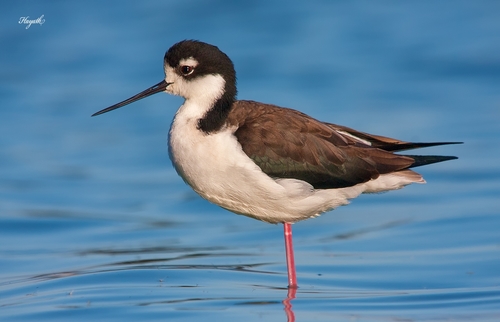
Black-necked Stilt
The Black-necked Stilt (*Himantopus mexicanus*) is a strikingly elegant shorebird known for its incredibly long, thin legs and contrasting black-and-white plumage. It plays a crucial role in wetland ecosystems, primarily as a predator of small invertebrates and occasionally small fish. This species is widely distributed across the Americas, showcasing a remarkable adaptability to various wetland habitats. While not globally threatened, some regional populations face pressures from habitat loss and degradation. The stilt's distinctive appearance and behavior make it a favorite among birdwatchers.
33-41 cm
Length
67-83 cm
Wingspan
Least Concern
Conservation Status
Distribution
The Black-necked Stilt is found throughout the Americas, from the southern United States and coastal Mexico, through Central America and the Caribbean, to South America, including parts of Peru, Ecuador, and Brazil. Some populations are migratory, moving north to breed and south for the winter, while others are resident year-round. They can be found at altitudes from sea level up to around 2,500 meters.
Lifespan
Up to 12 years in the wild, although average lifespan is likely shorter. Captive individuals may live longer.
Black-necked Stilt's Habitat
Habitat Types
Coastal marshes, Salt ponds, Mudflats, Shallow lake edges, Flooded fields, Mangrove swamps
Climate Zones
Tropical, Subtropical, Temperate
Adaptations
Their exceptionally long legs allow them to wade into deeper water than many other shorebirds, accessing a wider range of prey. Their long, thin bills are perfectly suited for probing in mud and shallow water for invertebrates.
Variations
Several subspecies have been proposed, with subtle variations in plumage and size, particularly in the extent of black on the head and neck. The Hawaiian Stilt, *Himantopus mexicanus knudseni*, is sometimes considered a full species and sometimes a subspecies. It has more black on the head and neck.
Appearance
Breeding Plumage
Plumage is generally consistent year-round, with a black back and wings, a white belly and breast, and a black neck and head. Some individuals may show a slight brownish tinge during non-breeding season.
Seasonal Feather Changes
Minimal seasonal variation.
Sex Based Plumage Differences
Males tend to have a glossier black back than females, particularly during the breeding season. Females may show a brownish tinge to the back.
Notable Features
Extremely long, pink legs, Long, thin, straight black bill, White spot above the eye, Red eyes
Diet and Feeding
Primary Foods
Aquatic invertebrates, Crustaceans, Insects, Mollusks, Small fish, Tadpoles, Seeds (occasionally)
Foraging Behavior
Black-necked Stilts primarily forage by wading in shallow water, visually spotting prey and then probing or pecking with their bills. They may also sweep their bills through the water or mud to locate food.
Specializations
Their long legs and bills are key specializations for feeding in shallow water and mudflats. Their visual acuity is also well-adapted for spotting small, moving prey.
Seasonal Diet Variations
Diet may shift slightly depending on prey availability. For example, during insect outbreaks, they may consume more insects. In areas with seasonal flooding, they may take advantage of newly available food sources.
Behavior
Social Structure
Black-necked Stilts are often found in small flocks, particularly outside of the breeding season. During breeding, they may form loose colonies, with nests spaced relatively close together.
Communication
Loud, repetitive 'kik-kik-kik' calls, Alarm calls, a sharper 'kyip-kyip-kyip', Visual displays, such as wing-lifting and bowing
Migration
Some populations are migratory, undertaking long-distance movements between breeding and wintering grounds. Others are resident or only make short-distance movements in response to water availability.
Territorial or Group Behaviors
During the breeding season, Black-necked Stilts are highly territorial, defending their nesting areas aggressively from other stilts and potential predators. They are known for their 'mobbing' behavior, where multiple birds will harass and dive-bomb predators.
Conservation
Threats
Habitat loss and degradation (wetland drainage), Pollution (pesticides and other contaminants), Human disturbance (recreational activities), Climate change (sea-level rise, altered precipitation patterns), Predation (by introduced species in some areas)
Protection Programs
Wetland restoration and conservation projects, Designation of protected areas (e.g., National Wildlife Refuges), Monitoring of populations, Public awareness campaigns
Local National Laws
Protected under the Migratory Bird Treaty Act in the United States.
Population Trend
Stable
Population Estimates
The global population is estimated to be between 450,000 and 4,200,000 individuals.
Interesting Facts
Their legs are proportionally longer than almost any other bird, second only to flamingos.
This allows them to wade into deeper water than other shorebirds.
They are known for their 'popcorn' behavior.
When agitated or defending their nests, they will jump up and down repeatedly, resembling popping popcorn.
The Hawaiian subspecies is endangered.
It has a very small and localized population, and has suffered from introduced predators, and habitat loss.
Faqs about Black-necked Stilt
What is the difference between a Black-necked Stilt and an American Avocet?
While both are in the same family, Avocets have upturned bills, whereas Stilts have straight bills. Avocets also have different plumage, with rusty-colored heads and necks during breeding season.
Are Black-necked Stilts aggressive?
They can be very aggressive during the breeding season when defending their nests and young. They will actively mob predators, including humans, that get too close.
How can I help Black-necked Stilts?
Supporting wetland conservation efforts is crucial. You can also avoid disturbing nesting birds during the breeding season and advocate for responsible water management practices.
Copyright @ Nature Style Limited. All Rights Reserved.
 English
English